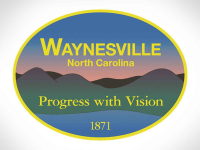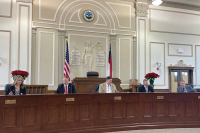Macon’s steep slope debate mired in details
In a somewhat surreal meeting last week of Macon County’s planning board, progress on developing regulations for steep slopes were stymied by turn-of-the screw technical discussions and semantic stumbling blocks.
The accuracy of GIS maps, the accuracy of the state’s landslide hazard maps and the meaning of the word “may” dominated the two-hour long meeting. Sorting through the debris, the biggest sticking point on developing a steep-slope ordinance for Macon County is, at least for now, planning board members’ ability to define an “influence zone.”
An influence zone, in theory, means that what you do on your land could be regulated if it impacts or threatens your neighbors.
More technically, and as debated for at least 30 minutes, an influence zone would be any area that “may be subjected to the effects of earth movement” from construction on another piece of property.
“The influence zone completely scares me to death,” Planning Board member Jimmy Goodman informed his fellow members.
Goodman’s fears, however, were expressed well into the discussion, long after the debate started over the meaning of the word “may,” at least as used in this context. Planning Board member Larry Stenger questioned why use “may” — instead just use “shall.”
Related Items
But the larger question is what happens once the influence zone is determined, in otherwords what regulations would then be triggered?
Ed Haight, a steep-slope subcommittee member, directed the group to another section of the proposal. Essentially, tougher regulations apply if the “influence zone” of a construction site is on a slope greater than 40 percent or a high landslide hazard area — even if the construction site itself doesn’t fall within that treshhold.
If your land lies in the high landslide hazard area or on a slope greater than 40 percent — or apparently if any work on your property “may” impact other property that is — the property owner must consult an engineer or other “design professional” before building.
For property-rights advocates such as Goodman and fellow planning board member Lamar Sprinkle, a local surveyor, such government regulation clearly seemed intrusive. What wasn’t clear is whether the two men were trying to deliberately sandbag the debate over steep-slope regulations by raising tangential issues, at best.
Sprinkle, in an out-of-left-field kind of way that seemed to raise the hackles of longtime planning board member Susan Ervin, among others, veered from Stenger’s concern over the word “may” into questioning the use of county GIS maps to determine property lines when it comes to a proposed steep slope ordinance.
“If you look at the GIS maps, that property line may not be accurately marked,” Sprinkle said.
“What is the point?” Ervin asked.
“If you are going to say what he’s got to do by the line of that map, and it ain’t right,” Sprinkle said, trailing off before Goodman jumped in.
“He (the presumed male hypothetical builder) may have to do geological work on someone else’s land,” Goodman finished.
“Not at all,” Ervin said.
“We’re just trying to do a site plan based on the GIS,” planning board member Al Slagle tried to interject. “It’s a preliminary way to look at it and hold the cost down for the property owner.”
“If that map is wrong, what are you going to do about that?” Sprinkle said.
Ervin asked what his point was, again, and Haight noted the process was “just a screening tool.” He might as well have thrown a pebble in to dam the flooding Mississippi River.
“I’m not arguing,” Sprinkle said before doing just that. “Have you ever been back in the mountains?”
“Yes, Lamar, I have been back in the mountains. Lamar, please tell us what is your point?” Ervin said.
“I’m telling you that if you are telling that man (the hypothetical male builder) that he has to do something based on those maps …” Sprinkle said before his conversation drifted off, then was interrupted by Slagle: “If it’s wrong, he’ll have an option to go to an administrator if he wants to appeal it, and he’ll have an appeals process,” Slagle said. “It is the same in any ordinance.”
Sprinkle, still undeterred, unabashed and unapologetic, then wanted to know about slope percentages in the event the GIS map lines were wrong.
“I’m thinking of all the difficulty a man’s going to have getting a building permit,” Sprinkle said. “Those maps are overlays … and a lot of them are grossly wrong, with lines running through houses.”
Haight asked how frequently that type of error actually does occur.
“You could come down to my office and stay there for about a year and see what I’ve seen,” Sprinkle suggested.
“Well, we’re moving on now,” planning board head Lewis Penland said, but to no avail. His board members weren’t done with the influence zone.
“I get worried when I see the word ‘may,’” Stenger said again, bringing the conversation full circle.
Lawyers for the county, Penland suggested, would work out such technicalities as “may” versus “shall,” and the debate eventually fizzled out without immediate resolution.
The planning board did manage to go completely through a list of definitions for the proposed steep slope regulation. Board members said they want commissioners to let them know if they want an actual draft ordinance written or not.
“I don’t want to sit here and waste my time writing an ordinance if it’s going to be shot down,” Slagle said, adding that was one point he and Sprinkle (who by then had left for another appointment) could agree on.
The planning board is set to meet again July 21 at 5 p.m. to discuss whether they are for or against individual sections of the proposed regulations.









